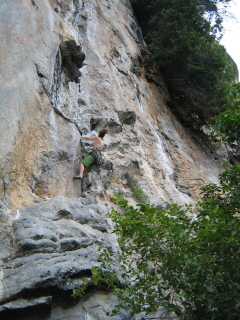User:Deborahgreen/My sandbox
Contents
The basics of Rock Climbing

Indoors and outdoors climbing
Rock climbing is a wholistic sport that can be practised both in and outdoors. Indoors, specially designed climbing walls covered in moveable holds can be used by the climber for either bouldering (lower level climbing without ropes) or route climbing with ropes for security. Outdoors, climbing can be done on established sport or traditional routes or the climber can choose to establish new routes on virgin rock.
Top rope climbing
Top rope climbing refers to climbs where the rope runs through anchors at the top of the route. The climber ties into one end and the belayer belays on the other. While the climber ascends, the belayers takes in the slack rope, thus should the climber fall, he or she will only drop a small distance.
Lead climbing
Lead climbing involves the climber carrying the rope up with him or her and clipping the rope into protection as he or she ascends.
- Sport lead climbing
- Sport lead climbing refers to climbs protected by stainless steel bolts drilled into the rock at intervals. Some of the bolts used are:
- Petzel hangers
- U-bolts
- Eye-bolts
- While ascending the route, the climber clips a carabiner and then his or her rope to these bolts.
- Traditional lead climbing
- In traditional climbing, the climber carries a variety of protection hardware up the route and places appropriate pieces of protection into the natural cracks and rails of the rock. Protection hardware may include:
- Nuts
- Slings
- Friends
- Hexes
- Tricams
- The climber then clips the rope through these pieces of protection.
- Falls in lead climbing
- Thus in both sport and traditional lead climbing, should the climber fall, the belayer will lock the belay device and the rope will catch the climber at the closest point of protection or bolt to the fall. This means there is potential for far larger falls than in top rope climbing.
- Key things to remember while lead climbing
- Lead climbing can be very dangerous and the following points should be remembered:
- Clip each and every bolt on sport routes and place regular pieces of protection on traditional routes. This will ensure that the length of each fall is minimised.
- Try to avoid too many zig-zags in your rope as it runs from clip to clip as this will cause friction drag.
- Do not clip from too far below the bolt in sport climbing as you will have to pull out a large amount of slack increasing the distance you will fall if you come off while clipping.
- Always clip the carabiner so that the rope runs from the belayer up the wall, through the back of the carabiner and out the front to you.
HIV/AIDS link about stigma:
Stigma Hopefully this link will show up I still have to get a copy of Open Office so that I can produce my own files for uploading.


